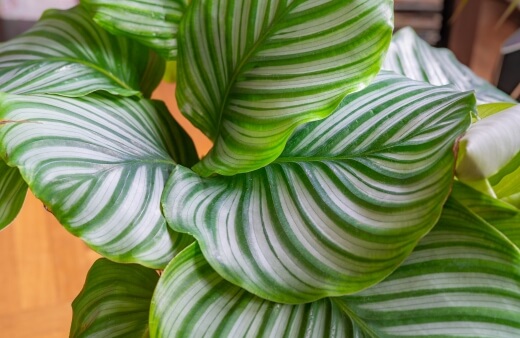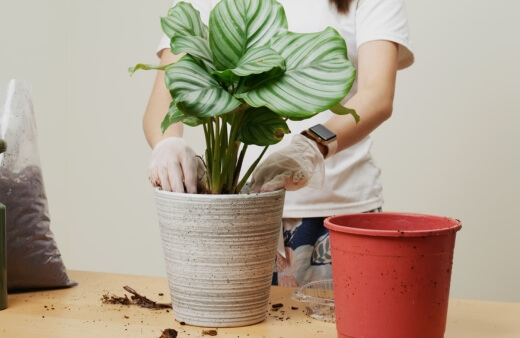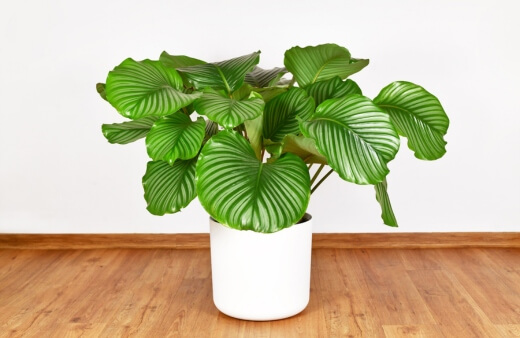Calathea orbifolia is a spectacular species of prayer plant prized for its distinctively striped variegated leaves. It is becoming a very popular houseplant in temperate zones globally thanks to the large and rounded vibrant leaves that can easily brighten up any living space.
The striking, bold patterned foliage sits gracefully on gently arching stems, offering highly ornamental applications indoors. While this plant can be a little tricky to care for, I’ll share all of our essential tips and tricks to hopefully allow your calathea to thrive and look its best.
Here is everything you need to know to grow and care for this showy houseplant in Australia.
More...

Family: | Marantaceae |
|---|---|
Genus: | Calathea |
Species: | C. orbifolia |
Other Name: | Goeppertia orbifolia |
Origin: | Bolivia |
Common Names: | Orbifolia prayer plant, white orbifolia |
Location: | Indoor |
Type: | Perennial, Herbaceous |
Growth: | Up to 1 metre tall and 60 centimetres wide |
Sun requirements: | Bright indirect light |
Foliage Colour: | Green with white stripes |
Flower Colour: | White (insignificant) |
Flowering: | Summer (rare indoors) |
Maintenance level: | Moderate |
Poisonous for pets: | Non-toxic to cats and dogs |
Getting to Know Calathea orbifolia
Renowned as an excellent air-purifying houseplant, Calathea orbifolia also features an advantageous growth habit where it will grow to fill pots and the leaves will also continue to get bigger as the plant grows.
Enjoy one of the most ornamental prayer plants in the genus along with some of the most striking foliage the family has to offer.
Part of the Marantaceae family of plants, Calathea orbifolia is commonly known as the orbifolia prayer plant or the white orbifolia. It has also recently been given an official secondary name, Goeppertia orbifolia.
This round-leaved prayer plant is native to Bolivia, South America where it naturally grows as leaf litter and ground cover on the rainforest floors. It thrives in tropical, subtropical and warm temperate climates.
Grown as a houseplant, it will usually grow up to 1 metre tall and 60 centimetres wide with leaves that can reach around 30 centimetres in width. Growing speed is considered moderately fast in good conditions but slower in mediocre conditions.
Calathea orbifolia Companion Plants
When considering possible companions for your Goeppertia orbifolia, it is important to remember that the plants you keep nearby will also need to enjoy similar conditions like high humidity and bright indirect light.
Here are some of our favourite companion plants for calathea indoors:
How to Grow Calathea orbifolia

To make the process as easy and fruitful for you as possible, we recommend establishing a healthy nursery plant. Being such a popular pick for houseplant enthusiasts, many reputable Australian nurseries should stock healthy tubestock plants that you can simply pop into the container of your choice or transplant into a larger pot if needed.
When choosing your calathea nursery plant, try to choose the healthiest-looking plant that has some new growth developing like a small leaf or two at its base.
Be sure to also check for any possible pests lurking about in the soil or around the foliage. This will ensure you avoid introducing unwanted pests into your home that could put your other houseplants at risk.
Alternatively, the orbifolia prayer plant, much like other rhizomatous plants, can be propagated using division. This process can be tricky as the plant is sensitive to being disturbed but it’s not impossible.
We recommend only trying this method if you’re experienced with propagating using division.
Propagating Calathea orbifolia Using Division
- Division should only be done during the active growing season in spring to summer.
- If you plan on repotting, you might want to divide your plant at the same time to minimise stress.
- Gently remove your Calathea orbifolia from its pot and try to be as gentle as possible when handling the roots.
- Find a healthy section with its own root system which should include at least one tuber and at least one healthy leaf, more if possible.
- Using a sharp and sterilised hand trowel or pair of secateurs, gently separate the section from the rest of the plant and immediately repot it into an appropriately sized container filled with fresh potting mix or soil.
- Water in the divided plant and keep the mix slightly moist but never soggy.
- Place it in a warm, sheltered location with medium indirect light.
- The divided plant will need some extra humidity to settle. You can put a clear plastic bag over the top then remove it every other day for some fresh air.
- The newly divided plant may need about 4 to 6 weeks to settle and start growing again.
Ideal Growing Conditions for Calathea orbifolia
As mentioned, these plants can be a little fussy with their growing conditions and environment. Luckily, even in less-than-ideal conditions, calatheas can adapt over time.
It is also important to note that Goeppertia orbifolia can be grown outdoors in tropical climate zones. I’ll cover some useful tips for growing them outdoors later in this section.

Here are the ideal conditions for growing the orbifolia prayer plant indoors.
Light Needs
They will thrive given bright, filtered or indirect light daily. Be sure to avoid any direct light as it can quickly scorch the foliage and cause the leaves to lose variegation. While these plants can also tolerate some shade and low light, the leaves will become less variegated and the overall plant vigour will be stunted.
Best Soil to Use
It is recommended to use a high-quality potting soil mix with good drainage. Your container should also feature good drainage to avoid the roots sitting in too much moisture which can quickly lead to rot issues.
Terracotta pots are an excellent choice; they absorb excess moisture and help prevent overwatering.
Temperature and Humidity
White orbifolia doesn’t tolerate low humidity and sudden temperature changes well. It is best to avoid drafts so place your plant away from any heating or cooling systems. Ideal temperatures are between 18°C to 27°C with medium to high humidity of 50% to 80%.
Tips for Boosting Humidity Levels
You can create some extra humidity around your plant by grouping plants together, misting regularly, or placing bowls of water near your plant to create a microclimate. Alternatively, you could place your plant in the kitchen or bathroom as these are naturally more humid rooms in the house.
Tips for Growing Calathea Orbifolia Outdoors
- Calatheas should only be planted outdoors in warm tropical and humid climates that don’t experience hard winter frosts.
- Outdoor-grown calatheas will need more shade to mimic their natural growing environment, sheltered beneath the tall rainforest canopy.
- Calathea will make for good border planting, and outdoor container gardening or used as a taller ground cover beneath shady trees.
- Plant in shade or filtered garden light to avoid the colourful leaf markings from fading.
- Allow for about 50cm to 60cm of space between plants.
- Water frequently to keep the soil moist but never soggy, especially during hot spells.
- Always water at soil level in the mornings for the best results.
- Add a 5cm to 10cm layer of mulch around the base of the plant in summer to keep the soil cool and moist.
- Feed with a quality balanced fertiliser 3 to 4 times between early spring and fall. Water well after fertilising.
Caring for Orbifolia Prayer Plant
The care required for this plant to thrive is very similar to that of many common houseplants. Here are some of the fundamental care tips for your Goeppertia orbifolia.

Watering Orbifolia Prayer Plant
This is the trickiest part as this plant hates being thirsty but also won’t respond well to overwatering. On average, water once every 1 to 2 weeks or when the top 2cm to 3cm of soil is completely dry.
Calatheas enjoy being kept relatively moist but never wet. During the winter months when the plant is not actively growing, you can reduce watering and try to use room-temperature water to avoid shocking the plant.
Pruning Needs
Cut off any dying or dead leaves as needed to ensure sufficient energy is going towards new growth. It is best to also trim away any brown leaf edges, sticking to the leaf shape to maintain plant aesthetics.
What Fertiliser to Use
Feed with a quality and balanced liquid houseplant fertiliser fortnightly over the warmer active months. No fertiliser will be required in winter.
Foliage Health
Using a damp soft cloth, wipe down the leaves about once per month to remove any dust to maintain the overall aesthetic and health of the leaves.
Repotting White Orbifolia
You will likely need to repot your plant once every 2 years or so depending on its growth. This will ensure the roots remain healthy and that the plant can get bigger over time. If you choose not to repot, it is recommended to at least give it some fresh soil at the same 2-year interval to keep it healthy.
After repotting, your calathea might struggle a little but this is normal. Just continue with your usual care routine and it will recover in time.
Orbifolia Prayer Plant Pests, Problems and Diseases
As with many houseplants, common pests are always a possibility. Luckily, this plant doesn’t struggle with any serious disease issues when grown in good conditions.
Here are some of the common issues these plants experience and how to deal with them.
Yellowing Leaves
This could be an indicator that your tap water may contain too much chlorine or fluoride. Try switching to distilled water or rainwater to see if the leaves recover. Alternatively, leave tap water standing for about 24 hours which will reduce the chlorine and fluoride content and then water your plant.
Powdery Mildew and Root Rot
Overly damp conditions and overwatering can lead to fungus forming on your calathea. These conditions can lead to fungal diseases like powdery mildew or root rot.
Powdery mildew appears as white patches of fungal growth on foliage whereas root rot leads to mushy stems, wilting leaves and an unpleasant rotten odour around the plant.
Here are some ways to treat these fungal issues:
- Cut back on your watering and allow the soil to dry out more often.
- Cut away any infected portions of the plant including foliage and roots.
- Remove as much old soil as possible from the top and add some fresh soil.
- Lightly prune the plant regularly to decrease its water demands while recovering.
- If you can, try rinsing the roots under some fresh water.
Aphids, Mealybugs, Gnats, Mites and Whiteflies
These common but pesky houseplant pests can be frustrating to deal with. Unfortunately, the large luscious leaves of Calathea orbifolia can attract them, especially in subpar conditions.
To treat these pest infestations, it is always best to use a pre-made insecticidal soap, horticultural oil or neem oil spray which will suffocate the pests and attack any larvae in the soil. You may need to continue treatment for a little while depending on the severity of the infestation.
If that doesn’t work, consider repotting your plant into completely fresh soil and discarding the old soil off-site. Be sure to quarantine the plant for a week or two before reintroducing it inside.
Calathea orbifolia Frequently Asked Questions

Is Calathea orbifolia hard to care for?
Goeppertia orbifolia plants are not the hardest houseplants to care for, but they are also not considered the easiest. The general musts for these plants are indirect light, warm temperatures, humidity, well-draining soil and standard watering.
How often should you water Calathea orbifolia?
As this plant does enjoy moist soil at all times, it is important to water regularly. Generally, water once the top 2 to 3 centimetres of soil is dry. Be sure to remove any excess water about 15 minutes after watering to avoid the plant sitting in water.
Is Calathea orbifolia rare?
Yes, this plant is considered a rare or less common calathea type. However, it is consistently gaining popularity in warm temperate regions globally thanks to its unique foliage.
Where is the best place for Calathea orbifolia?
This species of calathea naturally grows in the undergrowth of rainforests so when grown outdoors, it will thrive in brightly lit but still shady positions that mimic these conditions. Grown indoors, the plant requires a good amount of bright filtered light daily.
What are common problems with Calathea orbifolia?
Underwatering, overwatering and low humidity are the most common reasons this plant underperforms and develops issues.
Does Calathea orbifolia like to be misted?
Misting can be a great tool to help maintain healthy humidity levels for your calathea. Ideally, lightly mist your plant once every two to three days.
Looking for some inspiration with your calathea collection? Check out our main Calathea post and discover the most popular calatheas to grow in Australia.
Enjoy Beautifully Bold Foliage with Calathea orbifolia
A truly remarkable species in the genus, Calathea orbifolia will dazzle and impress year-round with its large variegated foliage that can easily brighten up any living space. While a little extra care may be needed to maintain this plant, it is fully worth it for that wow factor and the luscious influence it can add to our homes.
Calathea orbifolia is a great pick for those looking for their next indoor feature plant as it will quickly elevate your houseplant collection by adding some lovely texture and brilliance to your home through its uniquely stripped foliage and large rounded leaves.
Published on April 3, 2023 by Maisie Blevins
Last Updated on February 23, 2024




